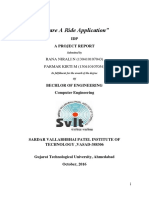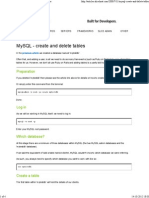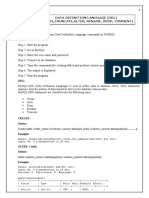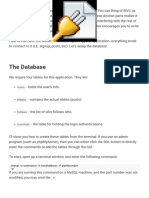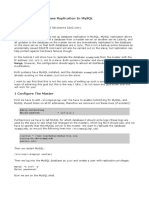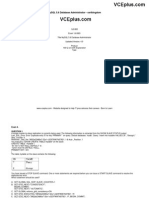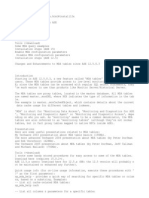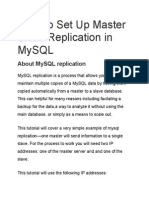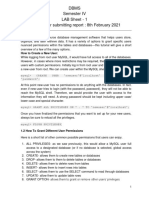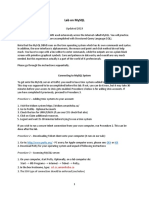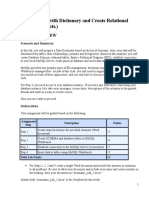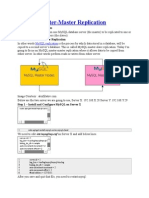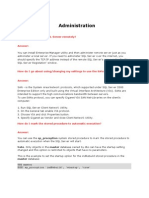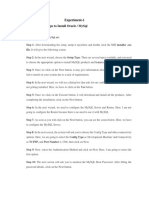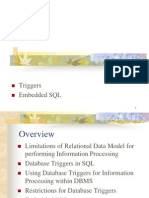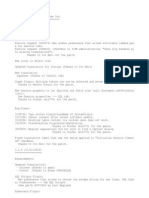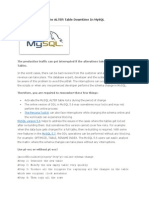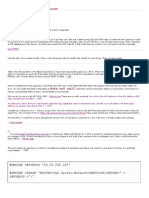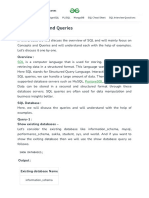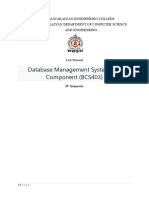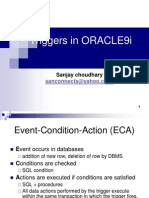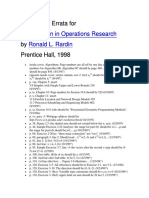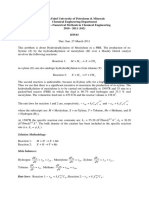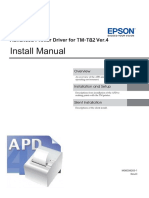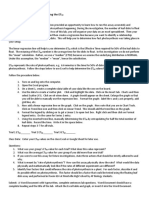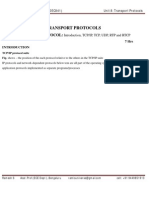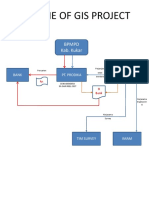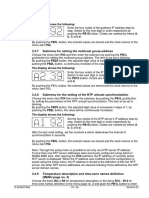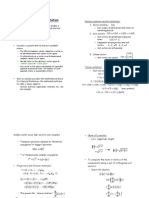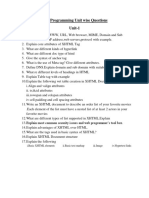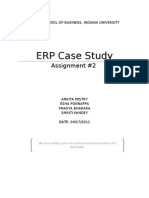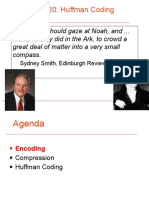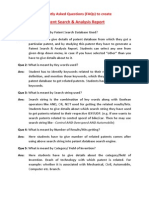MM Single Slave Repl
MM Single Slave Repl
Uploaded by
Pham Duy TruongCopyright:
Available Formats
MM Single Slave Repl
MM Single Slave Repl
Uploaded by
Pham Duy TruongOriginal Title
Copyright
Available Formats
Share this document
Did you find this document useful?
Is this content inappropriate?
Copyright:
Available Formats
MM Single Slave Repl
MM Single Slave Repl
Uploaded by
Pham Duy TruongCopyright:
Available Formats
MySQL Multi-Master Single-Slave Replication (aka Saskia)
Oli Sennhauser ( GNU FDL)
Rebenweg 6 CH 8610 Uster Switzerland oli.sennhauser@bluewin.ch
Introduction
through simple FEDERATED TABLES...
MySQL provides its replication for High Availability (HA) and for read Scale-out. Generally it is known that in a MySQL replication you can only replicate from one Master to many slaves.
M1
M2
M S S1 S2 S3 SF
...
It is told, that it is NOT possible to replicate from several masters to a single slave. It is also told, that this will be solved in future releases of MySQL.
M1
M2
The federated Slave (SF) can be put on the same server as the real Slave (S). From the application point of view everything looks transparent. And from the server infrastructure it also does not look to complicated. This concept does not work, if you have a write I/O bottleneck on the slave server. Replication should not have a problem with this configuration and should work as usual. If somebody finds any error in this concept, please let me know.
M1 S
M2
X
S SF
But possibly some MySQL users cannot or do not want to wait. Thus we were thinking about a possible simple solution with MySQL's own tools. The idea behind it is quite simple (and thus matches to the KISS concept): One master replicates to a simple slave. The second master replicates to an other slave which is connected to the first slave
Prof of Concept (PoC)
This step can be checked as follows:
master1>SHOWVARIABLESLIKE'server%'; +++ |Variable_name|Value| +++ |server_id|1| +++ master1>SHOWMASTERSTATUS; +++ |File|Position| +++ |bin_log.000009|362| +++ master2>SHOWVARIABLESLIKE'server%'; +++ |Variable_name|Value| +++ |server_id|2| +++ master2>SHOWMASTERSTATUS; +++ |File|Position| +++ |bin_log.000001|98| +++
For proving, if this concept works, the following playground was built:
M1
name = 5.1.11 port = 3315 user = repl1 server_id = 1 tables = m_equal, m_t1 -
M2
name = 5.1.9 port = 3309 user = repl2 server_id = 2 tables = m_equal, m_t2
S
name = 5.1.14 port = 3312 user = repl3 server_id = 10 tables = m_equal, m_t1, m_t2 -
SF
name = 5.1.12 port = 3322 user = none server_id = 20 tables = m_equal, m_t2
The name is an internal name of my set-up (corresponds to the underlying MySQL version). Because all 4 databases (instances) are running on the same host different ports have to be chosen for each database. On both masters a replication account has to be created. The replication account on the Slave (S) is used for the FEDERATED tables to propagate the data. To prevent any conflicts four different server_id's are chosen as usual for replication. On both Masters M1 and M2 two tables are created. One table to simulate a table which exists in both masters (m_equal) and one table to simulate tables which only exist on one of both masters (m_t1 and m_t2). All three tables have to exist on the Slave (S). The tables on the federated Slave have to be created differently.
We skip the step to do a proper backup here because we only want to prove that the concept works. In fact it is a little bit trickier than setting up a simple replication (mysqldump --skip-add-drop-table, ...). In this area some more investigation has to be done. Now the tables have to be set up. On both masters (M 1 and M2) as well as on the Slave S this table has to be created:
mysql>CREATETABLEm_equal( idINTUNSIGNEDNOTNULLAUTO_INCREMENT PRIMARYKEY ,tsTIMESTAMPDEFAULT CURRENT_TIMESTAMP ,dataVARCHAR(32) );
Set-up
Let us start with the two masters: First the server_id and binary logging (log_bin) have to be set and the databases have to be restarted. Then the normal replication accounts have to created on the masters:
master1>GRANTREPLICATIONSLAVE ON*.* TO'repl1'@'%' IDENTIFIEDBY'repl1'; master2>GRANTREPLICATIONSLAVE ON*.* TO'repl2'@'%' IDENTIFIEDBY'repl2';
On Master 1 (M1) and the Slave (S) the following table was created:
mysql>CREATETABLEm_t1( idINTUNSIGNEDNOTNULLAUTO_INCREMENT PRIMARYKEY ,tsTIMESTAMPDEFAULT CURRENT_TIMESTAMP ,dataVARCHAR(32) );
On Master 1 (M1) and the Slave (S) the analog table was created:
mysql>CREATETABLEm_t2( idINTUNSIGNEDNOTNULLAUTO_INCREMENT PRIMARYKEY ,tsTIMESTAMPDEFAULT CURRENT_TIMESTAMP ,dataVARCHAR(32) );
Testing
When the set up is finished we can start with some tests:
master1>INSERTINTOm_t1 VALUES(1,NOW(),'Bla'); master2>INSERTINTOm_t2 VALUES(1,NOW(),'Bla'); slave>SELECT* FROMm_t1t1 JOINm_t2t2ONt1.id=t2.id; ++++ +++ |id|ts|data|id|ts |data| ++++ +++ |1|2006122020:40:48|Bla|1| 2006122020:41:02|Bla| ++++ +++
Now nearly everything is set up except our federated Slave (SF). For setting up the federated Slave we first need an account on the main Slave (S):
slave>GRANTINSERT,UPDATE,DELETE ON*.* TO'feed_user'@'%' IDENTIFIEDBY'feed_user';
Then the two tables which belong to the Master 2 (M 2) have to be created in the federated Slave (S F) as FEDERATED tables:
slave_f>CREATETABLEm_t2( idINTUNSIGNEDNOTNULLAUTO_INCREMENT PRIMARYKEY ,tsTIMESTAMPDEFAULT CURRENT_TIMESTAMP ,dataVARCHAR(32) )ENGINE=FEDERATED CONNECTION='mysql://repl3:repl3@master:3312/t est/m_t2'; slave_f>CREATETABLEm_equal( idINTUNSIGNEDNOTNULLAUTO_INCREMENT PRIMARYKEY ,tsTIMESTAMPDEFAULT CURRENT_TIMESTAMP ,dataVARCHAR(32) )ENGINE=FEDERATED CONNECTION='mysql://repl3:repl3@master:3312/t est/m_equal';
A simple INSERT seems to work. :-) No a little bit more difficult:
master1>INSERTINTOm_equal VALUES(1,now(),'Bla'); master2>UPDATEm_equal SETdata='Blabla' WHEREid=1; slave>SELECT* FROMm_equal; ++++ |id|ts|data| ++++ |1|2006122016:16:36|Blabla| ++++
Now the slaves can be started as usual:
slave>CHANGEMASTERTO master_host='master' ,master_port=3315 ,master_user='repl2' ,master_password='repl2' ,master_log_file='bin_log.000009' ,master_log_pos=362; slave>STARTSLAVE; slave_f>CHANGEMASTERTO master_host='master' ,master_port=3309 ,master_user='repl2' ,master_password='repl2' ,master_log_file='bin_log.000001' ,master_log_pos=98; STARTSLAVE;
Also this seems to work correctly (but should NEVER be done because master 2 should not know anything about row 1). So it looks like everything works like in a normal replication...
Transactions
MySQL supports transactions on FEDERATED tables since release 5.1. Even transactions seems to work (the tables have to be change to InnoDB before):
slave>SELECT*FROMm_t2; ++++ |id|ts|data| ++++ |1|2006122113:45:10|Trxtest1| ++++ master2>mysql>BEGIN; master2>INSERTINTOm_t2VALUES(2,'2006 122113:49:10','Trxtest1');
slave>SELECT*FROMm_t2; ++++ |id|ts|data| ++++ |1|2006122113:45:10|Trxtest1| ++++ master2>UPDATEm_t2SETdata='Trxtest2' WHEREid=1; master2>COMMIT; slave>SELECT*FROMm_t2; ++++ |id|ts|data| ++++ |1|2006122113:49:10|Trxtest2| |2|2006122113:49:10|Trxtest1| ++++
tions and limitations are applicable [1], [2]. SET statements are not inherited through the FEDERATED storage engine. This makes it impossible to use features like AUTO_INCREMENT or NOW()/CURRENT_TIMESTAMP. Row based replication, which is new in 5.1 does not work in the Master 2 chain.
Outlook
This kind of replication enables to design much more complex database architectures. It allows us to model some kind of data flows from several different databases to some others...
M1
M2
M3
Also a rollback works.
Conflicts
Additionally to the usual Master-Master conflicts we also have here some other conflict potential: AUTO_INCREMENT and NOW()/CURRENT_TIMESTAMP values are not propagated through the FEDERATED table. These values get lost and this causes corrupt data on the Slave (S). Auto_increment_increment and Auto_increment_offset do not help here. See also Bugs. Rows in the shared table can be deleted from the Master where they never have been inserted (see example above). This causes the other master to be out of sync and leads to possibly corrupt data.
S1
S2
S3
S4
If someone introduces such a construct in production I would very appreciate it to get some feedback from out there...
Recommendations
Accessing the same table from different masters (m_equal) is tricky. Errors can creep in which are difficult to detect later. So it is recommended to use a shared table with care. On the dedicated tables (m_t1 and m_t2) the AUTO_INCREMENT should work, if the values are in sync. But they can easily get out of sync which causes corrupt data. Using this kind of set-up is pretty dangerous and has to be tested very careful.
Thanks to ...
... Ralf Gebhardt, Saskia Schweitzer and Jens Bollmann (who still hangs on an European Airport) for the contribution.
References
Limitations
It looks like normal DML (INSERT, UPDATE and DELETE) works fine. DDL (CREATE TABLE, ALTER TABLE, etc.) will only work on the Master 1 (M 1) chain but not on the Master 2 (M2) chain! TRUNCATE TABLE on the other hand seems to work properly on both chains. Each FEDERATED table creates a permanent database connection to the data provider database (at least with release 5.1.12). This means, that this kind of replication will NOT work with too many tables. The limit will be around some dozens to some hundreds of federated tables. But this should be sufficient enough for most uses. For FEDERATED tables and replication the usual restric-
[1] Limitations of the FEDERATED Storage Engine: http://dev.mysql.com/doc/refman/5.1/en/federated-limitations.html [2] Replication Features and Known Problems: http://dev.mysql.com/doc/refman/5.1/en/replication-features.html
Bugs
#20724, FEDERATED does not honour SET INSERT_ID: http://bugs.mysql.com/bug.php?id=20724 #20026, FEDERATED lacks support for auto_increment_increment and auto_increment_offset: http://bugs.mysql.com/bug.php?id=20026
You might also like
- Blue Prism - Development Best Practice PDFDocument40 pagesBlue Prism - Development Best Practice PDFbnanduri0% (1)
- Project Report On Share A Ride ApplicationDocument33 pagesProject Report On Share A Ride ApplicationRana Nirali100% (1)
- Patricia MineDocument8 pagesPatricia MineAndreeaFlorescuNo ratings yet
- Medical and Surgical Nursing AssessmentDocument1 pageMedical and Surgical Nursing AssessmentNagelli Sunish0% (2)
- Mysql - Create and Delete Tables: PreparationDocument4 pagesMysql - Create and Delete Tables: PreparationRajiv SivalingamNo ratings yet
- Data Definition Language (DDL) (Create, Truncate, Alter, Rename, Drop, Comment)Document38 pagesData Definition Language (DDL) (Create, Truncate, Alter, Rename, Drop, Comment)VijayaprabaNo ratings yet
- How To Set Up Mysql Master-Master Replication: IntroDocument5 pagesHow To Set Up Mysql Master-Master Replication: IntroDuy NguyenNo ratings yet
- How To Set Up A Load-Balanced MySQL ClusterDocument17 pagesHow To Set Up A Load-Balanced MySQL ClusterdennisNo ratings yet
- Creating A Blog Using Laravel 4 Part 1Document9 pagesCreating A Blog Using Laravel 4 Part 1Riki NovianNo ratings yet
- Ribbit Instagram Clone em PHPDocument33 pagesRibbit Instagram Clone em PHPGuilherme AyinNo ratings yet
- Create A Master Master MySQL ReplicationDocument4 pagesCreate A Master Master MySQL ReplicationHalim Maulana LNo ratings yet
- Powershell Script 1Document9 pagesPowershell Script 1Mabu DbaNo ratings yet
- How To Set Up Database Replication in MySQLDocument4 pagesHow To Set Up Database Replication in MySQLangdrake100% (1)
- STEP by STEP How To Setup Mysql Replication & DBA RefDocument18 pagesSTEP by STEP How To Setup Mysql Replication & DBA Refgopinathkarangula100% (1)
- Using Mysql Extensions: Ramkumar LakshminarayananDocument39 pagesUsing Mysql Extensions: Ramkumar Lakshminarayananmeeraneela0808No ratings yet
- Mysql and Java: 1 RequirementsDocument7 pagesMysql and Java: 1 RequirementsS R Krishnan100% (1)
- WSUS MaintenanceDocument7 pagesWSUS Maintenancewaqas raheelNo ratings yet
- Mysql DocumentDocument60 pagesMysql DocumentSandeep BoyinaNo ratings yet
- Oracle - Certcollection.1z0 883.v2015.07.01.by - Forum.85qDocument42 pagesOracle - Certcollection.1z0 883.v2015.07.01.by - Forum.85qRoy ValenciaNo ratings yet
- Oracle InterviewDocument13 pagesOracle Interviewsubash pradhanNo ratings yet
- Microsoft Performance Dashboard For SQL Server 2008Document3 pagesMicrosoft Performance Dashboard For SQL Server 2008VictorNo ratings yet
- ViewsDocument88 pagesViewsSudheer NaiduNo ratings yet
- Install The MDA TablesDocument8 pagesInstall The MDA TablesKiwiny9999No ratings yet
- SQL ServerDocument184 pagesSQL ServerarchankumarturagaNo ratings yet
- Create A Mysql Database Using Mysqli and PdoDocument19 pagesCreate A Mysql Database Using Mysqli and PdoNaveen KumarNo ratings yet
- How To Set Up Master Slave Replication in MysqlDocument12 pagesHow To Set Up Master Slave Replication in MysqlHulu BuluNo ratings yet
- Dynamics Trucante Delete Cleanup para Export ImportDocument5 pagesDynamics Trucante Delete Cleanup para Export ImportEduardo MachadoNo ratings yet
- Transaction Time Validity in MySQLDocument12 pagesTransaction Time Validity in MySQLManish GourNo ratings yet
- Dbms Semester IV LAB Sheet - 1 Due Date For Submitting Report: 8th February 2021Document30 pagesDbms Semester IV LAB Sheet - 1 Due Date For Submitting Report: 8th February 2021Prathamesh Shailendra MoreNo ratings yet
- SQL Injection Tutorial by MarezziDocument9 pagesSQL Injection Tutorial by MarezziRavi ShankerNo ratings yet
- Mysql Lab 2017Document16 pagesMysql Lab 2017Tanmay BankarNo ratings yet
- Triggers: Create TriggerDocument11 pagesTriggers: Create TriggerVEERU5108No ratings yet
- Teradata Advanced SQL Part1 PDFDocument38 pagesTeradata Advanced SQL Part1 PDFBiswadip Seth100% (2)
- Mis621 - Lap ReportDocument14 pagesMis621 - Lap ReportSajidMahmoodChoudhuryNo ratings yet
- Oracle Interview Questions and AnswersDocument23 pagesOracle Interview Questions and Answersjagadish_val100% (2)
- Working With MySQLDocument10 pagesWorking With MySQLRajiv SivalingamNo ratings yet
- MySQL Server InstallationDocument6 pagesMySQL Server InstallationMildd AmrskNo ratings yet
- MySQL Master-Master ReplicationDocument7 pagesMySQL Master-Master ReplicationStephenEfangeNo ratings yet
- Hive Metastore HA - MySQL Replication For Failover Protection - HortonworksDocument18 pagesHive Metastore HA - MySQL Replication For Failover Protection - HortonworksHarsh100% (2)
- MSSQL 2 MysqlDocument12 pagesMSSQL 2 MysqlErwin GunawanNo ratings yet
- SQL Interview 2Document67 pagesSQL Interview 2Vamsi SagArNo ratings yet
- DBMS FileDocument44 pagesDBMS Fileup16394996549No ratings yet
- SQL Server Interview Questions With Answers Set 2 40 QuestionsanswersDocument31 pagesSQL Server Interview Questions With Answers Set 2 40 QuestionsanswersVladimir RađenovićNo ratings yet
- Week 5Document52 pagesWeek 5reflex24No ratings yet
- ChangesDocument49 pagesChangesPrabakaran ParimalaselvanNo ratings yet
- Mysql ConnectorDocument19 pagesMysql ConnectoranilNo ratings yet
- How Can You Avoid The ALTER Table Downtime in MySQLDocument2 pagesHow Can You Avoid The ALTER Table Downtime in MySQLtom clarkNo ratings yet
- SQL Day-5Document7 pagesSQL Day-5PRIYOBRATO BANIKNo ratings yet
- Computer 3Document18 pagesComputer 3MarifelNo ratings yet
- Up SizeDocument5 pagesUp SizeAjay BramheNo ratings yet
- Dbms Complete Lab ManualDocument177 pagesDbms Complete Lab ManualMouniga Ve75% (4)
- SQL Concepts and QueriesDocument11 pagesSQL Concepts and QueriesCh Muhammad Junaid GujjarNo ratings yet
- Mysql SQL InjectionDocument13 pagesMysql SQL InjectionAlessandro FoxNo ratings yet
- Dbms Lab ManualDocument27 pagesDbms Lab Manualkoreanindian05No ratings yet
- Triggers Basic Sql3Document21 pagesTriggers Basic Sql3saconnectsNo ratings yet
- Pipelined FunctionsDocument21 pagesPipelined FunctionsAtif KhanNo ratings yet
- MySQL Crash Course: A Hands-on Introduction to Database DevelopmentFrom EverandMySQL Crash Course: A Hands-on Introduction to Database DevelopmentNo ratings yet
- GETTING STARTED WITH SQL: Exercises with PhpMyAdmin and MySQLFrom EverandGETTING STARTED WITH SQL: Exercises with PhpMyAdmin and MySQLNo ratings yet
- Module 5 DaaDocument29 pagesModule 5 Daaravirajmca95No ratings yet
- Optimasi Waktu Lampu Pengatur Lalu Lintas Menggunakan Algoritma Genetika DipersimpanganDocument10 pagesOptimasi Waktu Lampu Pengatur Lalu Lintas Menggunakan Algoritma Genetika DipersimpanganArkham Zahri RakhmanNo ratings yet
- Skills Audit FormDocument10 pagesSkills Audit FormPurwanto Soe'ebNo ratings yet
- CHS ExamDocument3 pagesCHS Examsan nicolas100% (1)
- Android Is A Linux-Based Operating System ForDocument24 pagesAndroid Is A Linux-Based Operating System ForBhawikNo ratings yet
- Joint Venture Accounting (JVA) : SAP AG 2002Document38 pagesJoint Venture Accounting (JVA) : SAP AG 2002Himanshu OswalNo ratings yet
- Analyst's Notebook 8Document2 pagesAnalyst's Notebook 8AdiConstantinNo ratings yet
- Unit 04Document29 pagesUnit 04gaurav775588No ratings yet
- First Print Errata RardinDocument5 pagesFirst Print Errata RardinMarcelo ZiulkoskiNo ratings yet
- Che 560 HW3Document2 pagesChe 560 HW3Jagna LannaoNo ratings yet
- APD 456dWM T82Document70 pagesAPD 456dWM T82nofri andriNo ratings yet
- Porting The Helix MP3 Decoder Onto MicrochipDocument20 pagesPorting The Helix MP3 Decoder Onto MicrochipCarlosRealNo ratings yet
- Floating Disc Excel ET50Document1 pageFloating Disc Excel ET50FaintCentaurNo ratings yet
- Multimedia Communication - ECE - VTU - 8th Sem - Unit 8 - Transport Protocols, RamisuniverseDocument28 pagesMultimedia Communication - ECE - VTU - 8th Sem - Unit 8 - Transport Protocols, Ramisuniverseramisuniverse100% (3)
- Scheme & Cost of Gis ProjectDocument2 pagesScheme & Cost of Gis Projectahmad idhanNo ratings yet
- 3.2.7 Submenu For Setting The Multicast Group Address: The Display Shows The FollowingDocument1 page3.2.7 Submenu For Setting The Multicast Group Address: The Display Shows The FollowinggrwgNo ratings yet
- User Manual: Nasalance SystemDocument21 pagesUser Manual: Nasalance SystemAlvaro Esteban Silva ArriagadaNo ratings yet
- Dirac NotationDocument3 pagesDirac NotationJayaprabha KanaseNo ratings yet
- Web Programming Unit Wise Questions Unit-1Document5 pagesWeb Programming Unit Wise Questions Unit-1nittesh gowdaNo ratings yet
- SY CSE AY 2022 23 Syllabus 1 April 2023Document42 pagesSY CSE AY 2022 23 Syllabus 1 April 2023Cyrill HowellNo ratings yet
- Cisco IOS Master Command ListDocument12 pagesCisco IOS Master Command Listrrkk123No ratings yet
- ERP Case Study: Assignment #2Document8 pagesERP Case Study: Assignment #2Ankita MistryNo ratings yet
- Mechanical Design Expert CATIA V5Document294 pagesMechanical Design Expert CATIA V5Eduardo Ramirez100% (3)
- Huffman CodingDocument77 pagesHuffman CodingSyed Umair AnwerNo ratings yet
- Frequently Asked Questions For Patent SearchDocument6 pagesFrequently Asked Questions For Patent SearchhotniliNo ratings yet
- ELID MatrixvDocument92 pagesELID MatrixvPrecious Ann Perez PerezNo ratings yet



